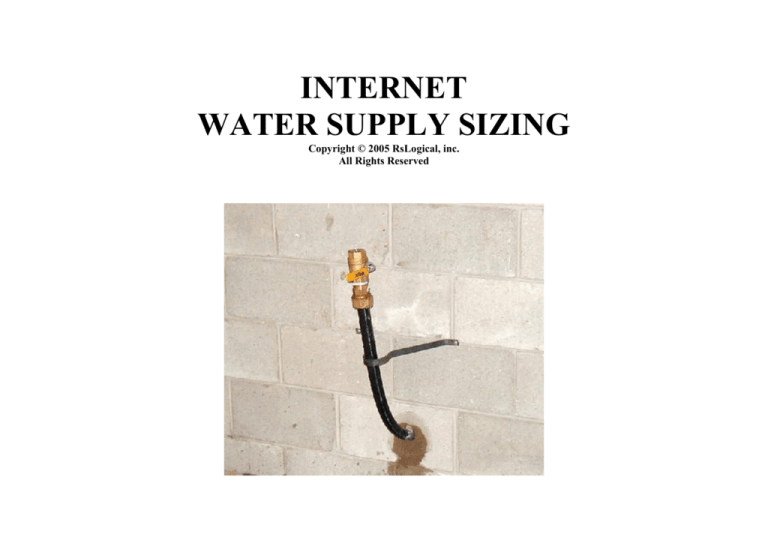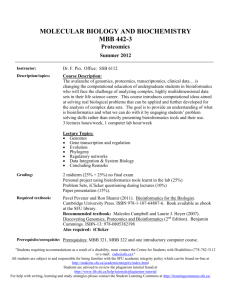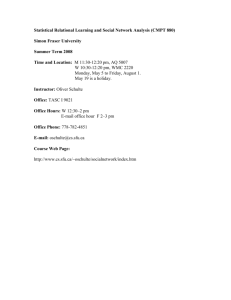
INTERNET
WATER SUPPLY SIZING
Copyright © 2005 RsLogical, inc.
All Rights Reserved
1
SIZING THE WATER DISTRIBUTION SYSTEM
Water distribution systems that are sized properly will not only
provide water in sufficient volume for the fixtures to operate, but also
reduce the chance for water hammer to occur in the system.
Velocities exceeding 8 feet per second in the piping will cause
erosion and water hammer.
This training booklet will help you to understand how to size the
water supply system using the Pressure Available For Uniform
Loss method. To do this you will need to have a copy of the WI
plumbing code and in particular Comm. 82.40. Tables 82.40-1
WATER SUPPLY FIXTURE UNITS FOR NONPUBLIC USE
FIXTURES and 82.40-3 CONVERSION OF WATER SUPPLY
FIXTURE UNITS TO GALLONS PER MINUTE will be used.
Tee back upstream to the Building control valve are assigned sfu’s in
a different manner than other parts of the system. That is because
these sections of pipe supply all the hot water sfu’s in the system and
the cold water sfu’s to any fixture downstream of the section of pipe
you are assigning the load to. This will be explained in greater detail
later.
Completing a Water Calculation Worksheet
Page 9 illustrates the completed water calculation worksheet. Using
the Total sfu from Table 82.40-1, add the total sfu’s from each
fixture and appliance in the dwelling. Find Table 82.40-1 on page 6.
Pages 4 and 5 illustrate a first floor plan and basement plan of a
typical ranch style home. There are 1-1/2 baths in this dwelling.
Page 11 contains an isometric drawing of the water supply system
with the sfu loads and pipe diameters. Cold water lines are
illustrated with a bolder line than the hot water lines for easier
identification. Several points along the piping are lassoed with
numbered tags. The numbers in those tags are the sfu load in that
section of pipe.
1 - Automatic Clothes Washer =
1 - Dishwashing Machine
=
2 – Hose Bibbs – ½”
=
1 – Kitchen Sink
=
1 - Laundry Tray
=
1 - Lavatory
=
1 - Water Closet
=
1 - Bathroom Group, W/BT
=
Totals sfu’s
1.0 hot
1.0 hot
0.0 hot
1.0 hot
1.0 hot
0.5 hot
0.0 hot
2.0 hot
6.5 hot
1.0 cold 1.5 total
0.0 cold 1.0 total
6.0 cold 6.0 total
1.0 cold 1.5 total
1.0 cold
1.5 total
0.5 cold
1.0 total
2.0 cold
2.0 total
3.5 cold
4.0 total
15.0 cold 18.5 total
The first valve after the water service enters the building is the
Building Control Valve. In the case of an interior pressure tank, the
Building Control Valve is the first valve downstream of the tank.
Building Control Valves shall be installed within 3 feet of developed
length of where a water service first enters a building and within 3
feet of developed length downstream of an interior pressure tank.
Note the total sfu’s is 18.5. In order to find the pressure loss in psig
in the water service and water meter if supplied, those sfu’s must first
be converted into gallons per minute. Table 82.40-3 on page 6 is
provided to do this conversion. Notice the line between 10 and 20
sfu’s in the table. 18.5 sfu’s is not shown so you must interpolate the
gpm. These are flush tank type water closets.
Another point of interest is the tee in the cold water line that connects
the water heater to the cold water supply. It is pointed out in the
isometric drawing on page 11. This tee is commonly referred to as
the Transition Tee. Sections of cold water pipe from the Transition
10 sfu’s = 8 gpm and 20 sfu’s = 14 gpm. The difference between 20
and 10 is 10 and the difference between 14 and 8 is 6. You must
divide the difference of 6 by 10 to find how much to add for every 1
fixture unit over 10 sfu’s. Dividing 6 by 10 results in .6 for every 1
2
fixture unit over 10. There are 8.5 sfu’s over 10 so multiply .6 by
8.5. .6 X 8.5 = 5.1 That means you add 5.1 gpm to 8 gpm and come
up with a conversion of 13.1 gpm demand of the building.
On the top of the water calculation worksheet there is a boxed in
area. Inside the box is the information required to find the loss in the
service and the pressure available at the building control valve.
There are other factors that affect the pressure at the building control
valve. Difference in elevation, (6 ft), Length of the service, (70 ft.)
and the low pressure at the connection to the water main or exterior
pressure tank, (48 psig)
Pressure loss in the water service
Now that you know the gpm demand of the building, the pressure
loss in psig within the service can be determined by using one of the
graphs in the Appendix of the code. This sample is going to use
Graph A- 82.40 (7)-6 PEX Tubing ASTM F876. Find that graph
on page 7 of this booklet. The flow rate is located along and up the
left side of the graph. The pressure loss due to friction (psig/100 ft of
pipe) is displayed along the bottom of the graph.
By following the graph line located at 13.1 across the graph until it
intersects with the 1” pipe size line you will find a circle. Looking
down the graph you will see that it is just over 10 psig/100 ft.
Actually it is 10.3 psig loss per 100 ft. of pipe. There is not a total of
100 ft in the service though. It is 70 ft in length. Therefore you
multiply 10.3 by .70 and the result is 7.2 psig loss in the service.
That loss is entered on line 7. Then subtract it from the pressure in
the water main (48) leaving 40.8 psig.
Next is the pressure loss or gain from the elevation difference
between the main and the building control valve. 6ft X .434 = 2.6
psig loss on line 8. Subtract line 8 from line 7 subtotal and line 9 is
38.2. Transfer 38.2 down to line B.
This sample has a 5/8 water meter installed. Page 8 has Graph
A-82.40(7)-1 illustrated with the graph line extending up from 13.1
gpm circled at the intersection of the graph line of a 5/8 meter. That
loss is 6.4 psig and is entered on line C. subtotal of the worksheet.
Subtracted from line B. the pressure available is 31.8 on line C.
subtotal.
The tub valve is a pressure balance valve, which requires 20 psig to
operate so that is the controlling fixture. Subtracted from 31.8 the
remainder is 11.8 psig on line D. subtotal.
The next step is the difference in elevation from the building control
valve to the controlling fixture, which is 12 ft. Multiplied 12 by .434
and there is pressure loss of 5.2 psig from the elevation difference.
That now leaves 6.6 psig on line E. subtotal.
There is no device creating an addition loss to the controlling fixture
therefore 6.6 is transferred down to G. subtotal.
Determine Line G. by taking a measuring tape and measuring along
the piping starting at the building control valve all the way to the
controlling fixture. Include the fittings and into and out of the water
heater if the controlling fixture is not a cold only fixture.
This sample is 76 ft for the developed length and equals 114 when
multiplied by 1.5. The A value in this sample is rounded up to 6.
Assigning Water Supply Fixture Units
In the sample used in this booklet there are 6.5 hot sfu’s. Assign the
sfu’s to the hot water piping first.
To the left of the water heater there are 2 sfu’s. Those 2 units come
from 1 hot unit of the Kitchen Sink and 1 hot unit of the Dishwashing
Machine. To the right of the water heater there are 4.5 sfu’s. 2 from
the Bathroom Group, 1 from the Laundry Tray, 1 from the Automatic
Clothes Washer and .5 from the Lavatory in the powder room.
3
Now that you know there are 6.5 sfu’s on the hot water, you can
determine the sfu’s on the cold water line that supplies the water
heater. Starting at the water heater, you must assign the units
backwards or upstream to the building control valve. That cold water
line on the upstream side of the Transition Tee not only supplies all
the hot water units, it also supplies the cold water past the water
heater. But only the balance of the total sfu of the fixture is added
from fixtures past the heater. In other words, the kitchen sink with a
total of 1.5 sfu’s has 1 sfu already included from the hot and you
only add .5 from the cold.
Notice that there are 4 sfu’s on the cold water line to the left of the
heater or past it. 3 sfu’s come from the ½ inch hose bibb and 1 sfu
from the cold of the kitchen sink. Remember now that pipe is past
the Transition Tee so it only supplies the cold water to those fixtures.
This may confuse you because to the right of the heater or upstream
of the Transition Tee, the pipe supplies 10 sfu’s. You can’t add the
4 cold units past the heater to the 6.5 hot units to determine the load
upstream of the Transition Tee because the total of the Kitchen Sink
is 1.5 not 2. Therefore you have 6.5 from the hot, 3 from the hose
bibb and .5 or the balance of the total of the Kitchen sink.
The rest of the cold sfu’s from fixtures that connect to the cold line
back to the building control valve are added in the same manner.
Hose bibbs do not have hot sfu, so the total value is added. The cold
branches that come off the cold to the water heater are assigned the
full value of the cold because they only serve the cold to those
fixtures.
The sample drawing on the next page is an example of a water
distribution system in a 1-½ bath ranch home. There are 18.5 total
water supply fixture units. Count them yourself by using Table
82.40-1 (Nonpublic Use Fixtures). Notice that there are 6.5 hot
sfu’s. That is the sfu you start with at the transition tee to the heater.
There is a Dishwasher, Kitchen Sink and ½” Hose Bibb on the cold
past the water heater. You do not add the full value of the cold sfu to
the 6.5 hot sfu to determine the load on the upstream side of
Transition tee. Remember that fixtures other than lavatories have a
total that is less than the hot and cold sfu combined. That’s because
the faucet port will not allow the full flow of both the hot and cold.
But if either one is used alone you will get the full sfu flow. So you
do not add 4 + 6.5 to find the load on the upstream side of the
Transition tee. You only add the full 3 sfu from the Hose Bibb
(because there is no hot) and the .5 sfu that is the balance of the
kitchen sink total. Remember that 1 sfu is already on the upstream
side of the Transition tee from the hot of the Sink. Therefore 10 sfu
is the load on the point.
Notice that the tag with 5.5 is the full load of the cold sfu’s because
that cold line does not serve the water heater. Tags with 13, 15.5 and
18.5 are lassoed around the cold water line that serve the water
heater. Therefore only the balance of the total sfu’s less all the hot
sfu’s from fixtures served by that pipe is added to the total hot sfu’s
to determine the load in the tagged section.
The last step is to size the distribution piping by using the tables
provided in Comm.82.40. This sample home is going to use CPVC
Tubing ASTM D2846 for the distribution piping so Table 82.40-8
has been included on page 10.
A dark line is provided under the pressure available for uniform loss
in the first column and stretches across the table. These are FT or
flush tank fixtures in the system, which means the maximum load on
the sections of each size of pipe shall not exceed the sfu’s listed just
above the dark line. 7.0 are the maximum sfu’s for 3/4 inch diameter
pipe and 15.5 is the maximum sfu’s for 1 inch diameter piping.
The pipe diameters required at the changes are shown on the
isometric plan on page 11.
4
5
6
1
1
2
1
1
1
1
18.5
1
7
8
9
10
11
12
Sizing the Water Supply
Exercise 1
Copyright © 2005 RsLogical, Inc.
All Rights Reserved
13
Sizing the water supply
Exercise 1
Contents
Page no:
13
14
15
16
17
18
19
20
21
22
Instructions
1st Floor plan of exercise house
Basement plan of exercise house
Isometric drawing of the water distribution system
Tables 82.40-1 and 82.40-3
Water Calculation Worksheet
Water Calculation Worksheet
Graph 82.40(7)-7; PE Copper Tube Size
Graph 82.40(7)-1; Water Meters
Table 82.40-8; CPVC tubing ASTM D2846
Instructions
This is Exercise 1 of the Internet Water Supply Sizing course. Inside this packet are the tables, graphs, drawings and worksheets you will need to
complete this exercise. Fill out the water calculation worksheet from the information below. Label the sfu’s and sizes at the tags of this exercise.
When Exercise 1 and Exercise 2 have been completed, log onto your course at rslogical.com and complete the 101 questions there.
Use the following information to complete the water calculation worksheet:
Low pressure at the water main; 50 psig;
Water service from the main to the lot line is 1-1/4 inch PE copper tube size 35 ft in length
Water service from the lot line to the building control valve is 1-inch PE copper tube size 75 ft in length;
Difference in elevation between the main and the building control valve; 5 ft;
3/4 Water meter;
Pressure required at the controlling fixture, pressure balance tub valve; 20psig
Elevation from the building control valve to the controlling fixture; 12 ft
Developed length from the building control valve to the controlling fixture; 80 ft
Water distribution material is CPVC Tubing ASTM D2846
14
15
16
17
18
19
20
21
22
23
Sizing the Water Supply
Exercise 2
Copyright © 2005 RsLogical, Inc.
All Rights Reserved
24
Exercise 1 was a refresher in water distribution sizing for a small ranch type dwelling unit that could well be located in a municipal setting. In
outlaying areas water softeners are commonly installed and result in lower operating pressure. The following pages describe an alternate approval
of a conversion table of SFU’s to GPM. It applies to single-family dwellings or single dwelling units in multi-family buildings. This new table
has greatly reduced the GPM load created by SFU’s. But it can apply only to sizing the water softener and finding the pressure loss through
it. Table 82.40-3 must still be used to find the GPM demand of the building and the in all other lines of the water calculation worksheet.
If a dwelling has more than 40 SFU’s in the water distribution system, the table does not apply. The table also will not apply when the demand of
any fixture exceeds the GPM listed in the new table. Be careful when using this table as there are many tub and shower faucets which demand a
greater than average supply of water and pressure. When adding up the total SFU’s, hose bibbs are not included in the load because the softener
does not serve them.
The letter of approval issued by the department is displayed on the next few pages of this packet. Note the 6 stipulations that are included in this
approval. Stipulation 6 states that the GPM flow rate used to find the pressure loss from the softener shall not be less than any faucet or fixture
requirement as stated by the manufacturer. That will apply to many body showers and roman tub type fillers.
For this exercise, all the fixtures except the 2 outside hose bibbs are to be included in the calculations. A sample calculation to find the pressure
loss from a softener is displayed on page 27. This exercise will use the same manufacturer’s table as displayed on page 27. There is an additional
worksheet on page 28. Page 29 displays the piping plan from exercise 1 with modifications for the water softener. After you have finished the
new water calculations and determine a new “A” value, assign SFU’s and sizes to the drawing on page 29. The developed distance is going to be
greater now because the piping goes through the water softener on the way to the controlling fixture.
When exercise 1 and exercise 2 are both completed, log onto rslogical and enter your answers.
Use this information to complete the Water Calculation Worksheet
The new developed distance from the building control valve to the controlling fixture is 100 ft.
Fill out the worksheet supplied on page 28. You can start with the same number from exercise 1 on line E. subtotal.
Use the drawing supplied on page 29 and maximum load table 82.40-8 from exercise 1 to assign SFU’s and sizes to the drawing.
After completing both exercise 1 and exercise 2, log onto rslogical.com and enter your answers.
25
26
27
GPM
4
5
6
7
8
9
10
11
800
5.2
6.5
7.5
8.4
9.5
10.1
10.8
12.5
1200
4.5
5.7
6.5
7.5
8.4
9.5
9.8
10.5
1600
4.0
5.2
6.0
6.5
7,2
8.4
9.1
9.8
2250
3.5
4.8
5.8
6.2
6.8
7.5
8.4
9.1
28
29








